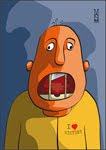The Temptation of St Anthony
I encountered that legend by reading the book of Gustave Flaubert. This quite surrealistic text caused excitement and storm in my fantasy. The story of St Anthony was very inspiring to many other artists in history, probably because it gave freedom to imagination and creativity of the people. Particularly in the age - when media and the flood of fantastic images was missing - they could stand in the role of visionaries depicting monsters, worlds, creatures the ordinary peasant could fear of to death.
Here is a little selection of paintings dealing with the subject. 
Hieronymus Bosch c. 1500; Oil on panel
Bosch's spiritual heroes were the saints who endured both physical and mental torment, yet remained steadfast. Among the saints, Bosch's favorite was Saint Anthony, the subject of his triptych The Temptation of Saint Anthony which features physical punishment on the left wing, a Black Mass in the center, and the blandishments of food and sex on the right wing. St. Anthony's triumph over such trials is mirrored by those of other hermit saints and by the Passion of Christ. In Bosch's day, temptation not only had the meaning it has today, but also meant physical/mental assault by demons. So St Anthony is not only tempted by the pleasures of the flesh and so on, he is also beaten up and terrorized by the demons. The central panel of this triptych illustrates the kneeling figure of St Anthony being tormented by devils. These include a man with a thistle for a head, and a fish that is half gondola. Bizarre and singular as such images seem to us, many would have been familiar to Bosch's contemporaries because they relate to Flemish proverbs and religious terminology. What is so extraordinary is that these imaginary creatures are painted with utter conviction, as though they truly existed. He has invested each bizarre or outlandish creation with the same obvious realism as the naturalistic animal and human elements. His nightmarish images seem to possess an inexplicable surrealistic power.
Martin Schongauer ca. 1470–75, Engraving
Saint Anthony gazes serenely out at the viewer as frenzied demons grab at his limbs, clothes, and hair and pound him with sticks. Schongauer depicted these imagined creatures in a remarkably convincing way. His realistic description of their scales and fur point to his direct observation of animals, yet he compiled these naturalistic details to produce some of the most fantastic and grotesque fabrications in the history of printmaking. Although this is one of Schongauer's earliest prints, it was probably his most influential: Vasari recounted that even Michelangelo made a color drawing of the work at the age of thirteen.
Mathis Grünewald, c. 1515
It was painted for the monastery of St. Anthony Isenheim. Grünewald shows the saint harassed by hideous demons in the wilderness. The figure on the left suffers from the skin disease ergotism, known as "St. Anthony's fire", caused by eating contaminated rye.The work's original viewers were from hospital dedicated to skin diseases attached to monastery.
Max Ernst, 1945
Clearly inspired by Grünwald's painting on the same subject, but transmogrifies the landscape into dead water and "fishbone forest". Although Ernst lived in America from 1941, the setting of this work, painted in the wake of Second World War for a Hollywood film set evokes the devastated cities of Europe. St Anthony is inextricably entangled in a dense web of nightmarish creatures, phantasmagoria of the subconscious mind.
Salvador Dali, 1946
In this picture temptation appears to Saint Anthony successively in the form of a horse in the foreground representing strength, sometimes also symbol of voluptuousness, and in the form of the elephant which follows it, carrying on its back the golden cup of lust in which a nude woman is standing precariously balanced on the fragile pedestal, a figure which emphasizes the erotic character of the composition. The other elephants are carrying buildings on their backs; the first of these is a obelisk inspired by that of Bernini in Rome, the second and third are burdened with Venetian edifices in the style of Palladio. In the background another elephant carries a tall tower which is not without phallic overtones, and in the clouds one can glimpse a few fragments of the Escorial, symbol of temporal and spiritual order. This picture was painted in the studio that the artist occupied for a few days next to the Colony Restaurant in New York. It is the first and only time that he participated in a contest. It was an invitational artistic competition for a painting of the theme of the temptation of Saint Anthony, organised in 1946 by the Loew Lewin Company, a movie- producing firm. The winning picture was to figure in a film taken from the story "Bel Ami" by Maupassant. Eleven painters took part in the competition, among them Leonora Carrington, Dali, Paul Delvaux, Max Ernst, and Dorothea Tanning. The prize was given to Max Ernst by jury composed of Alfred Barr, Marcel Duchamp, and Sidney Janis. All these works were shown at an exhibition in Brussels and in Rome during 1947.
Salvator Rosa, 1646
St. Anthony was particularly solicitous about animals, to which a whimsical picture by Salvator Rosa represents him as preaching. From his practices, perhaps, arose the custom of blessings passed on animals still practised at Rome; he regarded all God's creatures as worthy of protection. The painting contains Rosa's own portrait.




